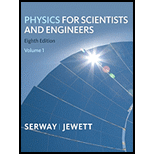
Concept explainers
A spherical shell has inner radius 3.00 cm and outer radius 7.00 cm. It is made of material with thermal
(b) Next, prove that
where T is in degrees Celsius and r is in meters. (c) Find the rate of energy transfer through the shell. (d) Prove that
where T is in degrees Celsius and r is in meters. (e) Find the temperature within the shell as a function of radius. (f) Find the temperature at r = 5.00 cm, halfway through the shell.
(a)
Answer to Problem 20.82CP
Explanation of Solution
The law of thermal conduction is,
Here,
The expression for the surface area of the sphere ism,
Substitute
Since the value of the coefficient of thermal conductivity is constant and the radius of the spherical surface is also constant. The thermal gradient becomes constant.
The rate of energy transfer is directly proportional to the thermal gradient. Since the thermal gradient is constant so the rate of energy transfer through the spherical surface is same.
Conclusion:
Therefore, the rate of energy transfer through the spherical surface is same because the temperature gradient is constant
(b)
To show: The given relation,
Answer to Problem 20.82CP
Explanation of Solution
Let the temperature is
Rearrange the equation (1) to prove the relation,
Integrate at both sides for temperature from
Conclusion:
Therefore, the equation,
(c)
Answer to Problem 20.82CP
Explanation of Solution
From the equation (1),
Integrate at both sides for temperature from
Conclusion:
Therefore, the rate of energy transfer through the shell is
(d)
To show: The given equation,
Answer to Problem 20.82CP
Explanation of Solution
Let the temperature is
Rearrange the equation (1) to prove the relation,
Integrate at both sides for temperature from
Substitute
Put the value of the
Conclusion:
Therefore, the equation,
(e)
Answer to Problem 20.82CP
Explanation of Solution
From the equation (1),
Integrate the above equation,
Conclusion:
Therefore, the temperature within the cell as a function of radius is
(f)
Answer to Problem 20.82CP
Explanation of Solution
From the equation (5),
Substitute
Conclusion:
Therefore, the temperature in spherical shell at radius.
Want to see more full solutions like this?
Chapter 20 Solutions
Physics for Scientists and Engineers, Volume 1, Chapters 1-22
- Lab Assignment #3 Vectors 2. Determine the magnitude and sense of the forces in cables A and B. 30° 30° 300KN 3. Determine the forces in members A and B of the following structure. 30° B 200kN Name: TA: 4. Determine the resultant of the three coplanar forces using vectors. F₁ =500N, F₂-800N, F, 900N, 0,-30°, 62-50° 30° 50° F₁ = 500N = 900N F₂ = 800Narrow_forwardLab Assignment #3 Vectors Name: TA: 1. With the equipment provided in the lab, determine the magnitude of vector A so the system is in static equilibrium. Perform the experiment as per the figure below and compare the calculated values with the numbers from the spring scale that corresponds to vector A. A Case 1: Vector B 40g Vector C 20g 0 = 30° Vector A = ? Case 2: Vector B 50g Vector C = 40g 0 = 53° Vector A ? Case 3: Vector B 50g Vector C 30g 0 = 37° Vector A = ?arrow_forwardThree point-like charges are placed at the corners of an equilateral triangle as shown in the figure. Each side of the triangle has a length of 20.0 cm, and the point (A) is located half way between q1 and q2 along the side. Find the magnitude of the electric field at point (A). Let q1=-1.30 µC, q2=-4.20µC, and q3= +4.30 µC. __________________ N/Carrow_forward
- Find the total capacitance in micro farads of the combination of capacitors shown in the figure below. 2.01 0.30 µF 2.5 µF 10 μF × HFarrow_forwardI do not understand the process to answer the second part of question b. Please help me understand how to get there!arrow_forwardRank the six combinations of electric charges on the basis of the electric force acting on 91. Define forces pointing to the right as positive and forces pointing to the left as negative. Rank in increasing order by placing the most negative on the left and the most positive on the right. To rank items as equivalent, overlap them. ▸ View Available Hint(s) [most negative 91 = +1nC 92 = +1nC 91 = -1nC 93 = +1nC 92- +1nC 93 = +1nC -1nC 92- -1nC 93- -1nC 91= +1nC 92 = +1nC 93=-1nC 91 +1nC 92=-1nC 93=-1nC 91 = +1nC 2 = −1nC 93 = +1nC The correct ranking cannot be determined. Reset Help most positivearrow_forward
 Principles of Physics: A Calculus-Based TextPhysicsISBN:9781133104261Author:Raymond A. Serway, John W. JewettPublisher:Cengage Learning
Principles of Physics: A Calculus-Based TextPhysicsISBN:9781133104261Author:Raymond A. Serway, John W. JewettPublisher:Cengage Learning Physics for Scientists and Engineers: Foundations...PhysicsISBN:9781133939146Author:Katz, Debora M.Publisher:Cengage Learning
Physics for Scientists and Engineers: Foundations...PhysicsISBN:9781133939146Author:Katz, Debora M.Publisher:Cengage Learning Physics for Scientists and Engineers, Technology ...PhysicsISBN:9781305116399Author:Raymond A. Serway, John W. JewettPublisher:Cengage Learning
Physics for Scientists and Engineers, Technology ...PhysicsISBN:9781305116399Author:Raymond A. Serway, John W. JewettPublisher:Cengage Learning
 College PhysicsPhysicsISBN:9781938168000Author:Paul Peter Urone, Roger HinrichsPublisher:OpenStax College
College PhysicsPhysicsISBN:9781938168000Author:Paul Peter Urone, Roger HinrichsPublisher:OpenStax College Physics for Scientists and EngineersPhysicsISBN:9781337553278Author:Raymond A. Serway, John W. JewettPublisher:Cengage Learning
Physics for Scientists and EngineersPhysicsISBN:9781337553278Author:Raymond A. Serway, John W. JewettPublisher:Cengage Learning





